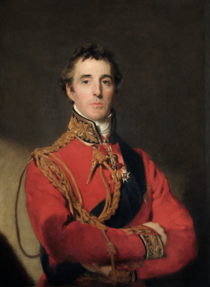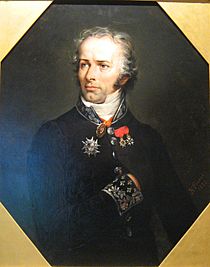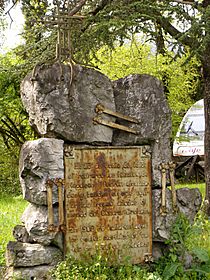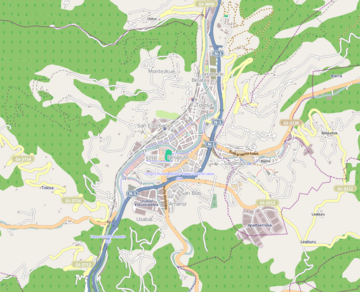Battle of Tolosa (1813) facts for kids
Quick facts for kids Battle of Tolosa (1813) |
|||||||
|---|---|---|---|---|---|---|---|
| Part of the Peninsular War | |||||||
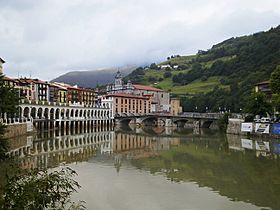 Tolosa lies in the deep valley of the Oria River. |
|||||||
|
|||||||
| Belligerents | |||||||
| Commanders and leaders | |||||||
| Strength | |||||||
| Casualties and losses | |||||||
| 24 June: 193 26 June: 619 |
24 June: 300 26 June: 400+ |
||||||
The Battle of Tolosa happened on June 26, 1813. It was a fight during the Peninsular War, which was part of the bigger Napoleonic Wars. In this battle, a group of British, Portuguese, and Spanish soldiers, led by Thomas Graham, tried to stop a French and Italian army from escaping.
The French force was led by Maximilien Sébastien Foy. Another French group, led by Antoine Louis Popon de Maucune, arrived just in time to help Foy. The French managed to hold off Graham's first attacks. Then, they cleverly slipped away when they were about to be surrounded. The town of Tolosa is located about 20 kilometers (12 miles) south of San Sebastián in Spain.
In the spring of 1813, the Allied army, led by Lord Wellington, launched a big attack. Their goal was to push King Joseph Bonaparte's French army out of Spain. On June 21, Wellington's army won a huge victory at the Battle of Vitoria.
As the defeated French armies retreated towards the Pyrenees mountains, Wellington tried to cut off some French groups. One was Foy's group in the north, and another was Bertrand Clausel's forces in the south. Neither Foy nor Clausel had fought in the Battle of Vitoria. Graham caught up with Foy's group, but the French still managed to escape. Clausel also avoided being trapped. Soon, most of northern Spain was free from French control, except for the sieges of San Sebastián and Pamplona. The next major battle was the Battle of the Pyrenees, which started on July 25.
Contents
Why the Battle Happened: The Vitoria Campaign
In early 1813, the French had many soldiers in Spain. But Emperor Napoleon ordered some of them to fight Spanish guerillas (local fighters) in northern Spain. This left King Joseph Bonaparte and his marshal, Jean-Baptiste Jourdan, with fewer soldiers to face Wellington.
Wellington's army was very strong. It had 52,000 British, 28,000 Portuguese, and 25,000 Spanish soldiers. The French Army of the North had 40,000 troops, but most were guarding places. Only about 10,000 could fight in the field.
In June 1813, Wellington's army kept attacking the French army's northern side. This forced King Joseph to order a long retreat. During this retreat, some French divisions joined Joseph. But the location of Clausel's soldiers was unknown.
On June 18, some French divisions accidentally ran into Wellington's advancing army at the Battle of San Millan-Osma. One French division, led by Maucune, was badly beaten. Joseph thought it was only good enough to guard the army's supplies. Wellington's army moved so fast that the French couldn't gather all their forces.
On June 19, Joseph's army reached Vitoria. They waited for Clausel to join them, but he never did. On June 21, Wellington attacked Joseph's army at the Battle of Vitoria. The Allies had about 88,000 soldiers and 90 cannons. The French had about 46,000 soldiers and 100 cannons.
The Allies lost about 4,900 men, while the French lost over 8,000. The French also lost 151 cannons and a huge amount of stolen goods. The French retreat turned into a chaotic escape. However, the Allies didn't chase them very hard. Many Allied soldiers stopped to loot the French supply wagons. Also, the Allied soldiers were tired after marching 20 miles that day.
On June 22, Wellington's army chased Joseph's forces east. Wellington also sent Spanish troops to the northeast to catch Maucune's convoy. At Salvatierra, Wellington sent another group under Graham north to cut off Foy and Maucune. Joseph's defeated army retreated past Pamplona on June 24.
On June 26, the Allies surrounded and began the Siege of Pamplona. That day, Wellington learned that Clausel's group was to his south. He sent several divisions to hunt them down.
Foy's Operations Before Tolosa
In April 1813, General Foy's division arrived in Bilbao, northern Spain. He soon had over 16,000 soldiers, including Italian troops. Foy was ordered to capture the port of Castro Urdiales.
On April 25, Foy left Bilbao with over 11,000 troops and reached Castro Urdiales. The port was defended by 1,000 Spanish soldiers and three British warships. The French brought up heavy cannons and quickly broke through the town walls. On May 11, the French attacked the town. Many French soldiers started looting, but the British ships managed to rescue most of the Spanish defenders. Both sides lost about 180 men.
On May 30, Foy trapped a group of Spanish irregular fighters. He killed 200 and captured 360.
Foy finally received new orders on June 19. He was told to join the main French army near Vitoria. However, Foy didn't realize how serious the situation was. He decided not to join the main army. His 5,000-man division was greatly missed at the Battle of Vitoria.
The Battle of Tolosa: The Fight Begins
Actions from June 22 to 25
On June 20, Foy ordered his troops to leave Bilbao. On June 21, the day of the Battle of Vitoria, Maucune's division left Vitoria. They were guarding a large convoy of supplies heading towards France. That evening, Maucune told Foy that he had heard cannons firing behind him. The next day, refugees arrived, telling of the French defeat and warning that Allied troops were chasing them.
Spanish troops under Longa left Vitoria on June 22. Girón's tired troops also left, but stopped when Clausel was found to the south. Foy, with only two battalions, managed to slow Longa's advance. By June 23, Foy gathered about 3,000 soldiers at Bergara. He faced Longa's division while waiting for more troops to arrive.
Graham's column and Girón's Spanish army were ordered to stop Foy's retreat. But bad planning and heavy rain slowed Graham's advance. Some of his troops made good progress, but others fell behind.
Foy was worried that Allied troops might cut him off. He told Maucune to keep the road open until his 8,000 soldiers passed the danger point. Maucune sent the convoy to Tolosa and then turned back. He placed one brigade to defend Villafranca de Ordicia and another to defend Beasain.
Foy's column left Villareal de Álava early on June 24. Longa's Spanish troops caught up with the Italians guarding Foy's rear, but couldn't stop them. Graham attacked Maucune with the soldiers he had. The Portuguese troops were pushed back at Villafranca at first, but eventually forced their opponents to retreat. The German light battalions attacked and captured Beasain. But Maucune pulled back to higher ground and kept fighting. Meanwhile, Foy's column passed behind Maucune and escaped towards Tolosa. On June 24, Maucune lost 200 men, and Graham lost 93. The Italians and Longa's Spaniards each lost about 100 men.
Graham commanded about 26,000 men. This included 16,000 Spaniards and 10,000 British and Portuguese soldiers. On June 25, Graham's lead troops met Maucune's division at Alegia and pushed them out of the town. Foy wrongly believed that Joseph's main army might be retreating towards the coast. So, he decided to defend Tolosa. He sent the convoy towards the French border, guarded by a brigade of four battalions.
The Main Fight on June 26
Foy had about 16,000 troops at Tolosa. These included his own division, Maucune's division, Italian troops, and various garrisons from nearby towns. Tolosa is on the main highway to France. The town is in the Oria River valley and surrounded by high hills. The French had strengthened Tolosa's old walls with strong points and protected the town gates.
Foy placed one brigade inside Tolosa. Other brigades held positions southeast of town and on a hill closer to town. Another brigade held high ground on the west bank of the Oria River. Maucune's division was kept in reserve on the main highway behind the town. Foy's position was very strong against a direct attack along the highway. Any attempt to go around his flanks would take a lot of time.
Graham realized he had to go around Foy's strong position. He sent most of his 1st Division, followed by other brigades, to face the town directly. But he sent Longa and Porlier on a wide sweep to the right. Their goal was to cut the road to Pamplona, which came out of the east side of Tolosa. Bradford's brigade was sent on a shorter hook to the right. One of Pack's battalions and some Spanish light infantry were sent to the left to attack the west side of town. Graham also asked a Spanish guerilla leader, Gabriel de Mendizábal Iraeta, to block the main highway north of Tolosa. The Allied center would wait until the flank attacks were well underway.
Bradford's attack on the right quickly gained a foothold across a stream. Foy later blamed his commander, Bonté, for not being watchful enough. Bonté's first counterattack failed, so he brought in the Italian brigade. Bradford's attack then slowed down. On the left, the Spanish-Portuguese column was stopped by a steep cliff.
Late in the afternoon, Graham heard the sounds of gunfire from Longa's division on the far right and Mendizábal's guerillas on the far left. The British commander ordered three German battalions in the center-right to attack. At the same time, two German light infantry battalions attacked Tolosa itself, supported by the Guards brigade and a Spanish division.
The 1st German Light Battalion tried to storm the Vitoria gate on the south side of town. They were stopped by heavy gunfire and had to fall back. They tried again but were pushed back by fire from the walls and blockhouses. The battalion lost 63 men killed and wounded in these attacks.
Meanwhile, the French and Italian soldiers on the left were hit by the German line battalions. They were pushed back towards the Pamplona gate on the east side of town. They couldn't enter Tolosa because the gate was blocked. So, they broke out and ran north along the town wall. The chasing German battalions attacked the Pamplona gate but were also pushed back.
On the west side of town, Mendizábal's guerillas fought with a French brigade. The Spanish-Portuguese troops, who had been blocked by the cliff, ran past the town walls on the west. They attacked the French flank. Some French new recruits panicked and ran away, but their commander managed to rally his brigade.
Seeing his defenses falling apart, Foy ordered his brigade inside Tolosa to pull out. The order came just in time. Cannons blasted open the Vitoria gate, and the German light battalions swarmed into the town. After some small fights in the town, the French brigade escaped with few losses. The flanking forces of Mendizábal and Longa caught some stragglers. But Foy's main force quickly marched away as darkness fell.
What Happened Next
Graham reported that his British and Portuguese soldiers lost 58 killed, 316 wounded, and 45 missing. Spanish casualties were estimated at 200. Foy admitted losing 400 men, but the Allies claimed to have captured 200 prisoners, so the French losses might have been higher.
That night, Foy's force camped at Andoain. The next day, Foy's army, which had about 16,000 infantry, 400 cavalry, and 10 cannons, retreated to Hernani.
Louis Emmanuel Rey was put in charge of defending San Sebastián on June 19. The city's defenses were not in good shape. Only about 500 police officers, an unreliable group of new recruits, and some engineers were available to defend the city. There were also 7,000 French and Spanish refugees crowding the city. When Foy arrived on June 28, he immediately sent troops and artillery experts to defend San Sebastián. The police and new recruits were used to escort the refugees to France. When Foy retreated across the Bidasoa River at the border, San Sebastián had a garrison of 3,000 soldiers. By June 29, Mendizábal's guerillas began the siege by cutting off all communication with San Sebastián. The first actions of the Battle of the Pyrenees began on July 25.
Images for kids


